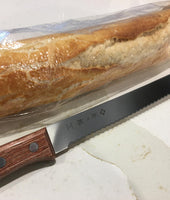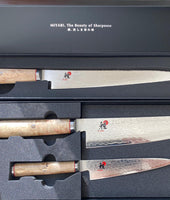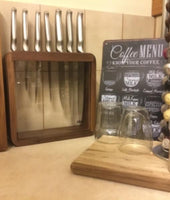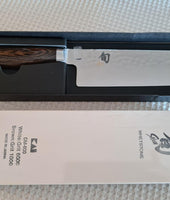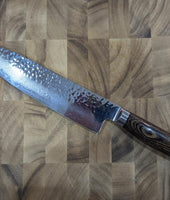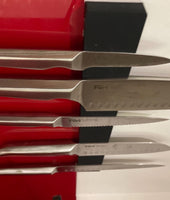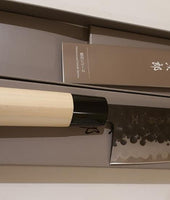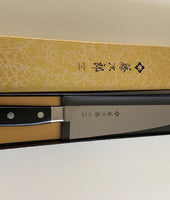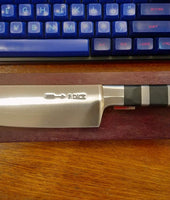Shun vs Miyabi Knife
When it comes to Japanese knives, you can't complain about the quality. Japanese knives are crafted using a combination of modern technology and traditional world-renowned sword-forging techniques. Lightweight, razor-sharp, and durable, Japanese knives are indispensable in the kitchen. This is why it's difficult to choose between Miyabi vs Shun chef knives.
Both are made in Japan, and in the same city. Both are made to the best possible standards (and knowing Japanese craftsmanship, those are quite high!). They even cost more or less the same. Still, they have one or two differences, which can lead you to choose one over the other, and we'll dive into those in this article.
The Miyabi 5000FCD Chef Knife Vs The Shun Classic Chef Knife
Originally designed for slicing and disjointing large beef cuts, chef knives have become indispensable in the kitchen. They are now used to perform other duties as well, such as slicing, chopping and mincing vegetables, and even cutting fish.
The Miyabi 5000FCD Chef Knife
In 2004, one of the top manufacturers of good quality knives in Seki, Japan, was acquired by Zwilling J.A Henckels, a German knife manufacturing company. Combining German engineering with the best Japanese skill, the company went on to produce Miyabi, a high-end brand of true Japanese knives.
The knives are designed and made by Japanese craftsmen in Japan using the traditional sword-making knowledge of ancient master forgers.
This knife features a singularly thin blade crafted using a VG10 'super steel' core protected by 65- layers of carefully forged steel.
The entire blade is surrounded by a beautiful Damascus pattern. For extra strength, corrosion resistance, and flexibility, the blade is taken through a four-step ice-hardening process. Experienced craftsmen then hand-finish the edges by honing the blades using a 3-step process called honbazuke. The blades are finely sharpened to give a lasting edge.
The Miyabi Kaizen knives come with durable black Micarta handles featuring mosaic pins, stunning red colors, and end caps with a logo. Micarta is a synthetic material manufactured mostly from linen, burlap, or canvas layers, which are laminated and glued together with resin. They are then compressed using heat to form the hard material commonly used to make kitchen knife handles.
While it is thinner than the Shun knife, the Miyabi chef knife is much sharper. The thinness of the blade also does not compromise on durability- it lasts just as long as the Shun blade.
The Shun Classic Chef Knife
Shun Cutlery is owned by the Kai Group, a Japanese company that boasts more than 100 years of experience in knife manufacture. Like the Miyabi brand, this company is also based in Seki City, Japan, and uses traditional Japanese craftsmanship to manufacture its knives. Shun knives easily lead the market in quality and dependability, and their aesthetic is well known and respected.
The blade of the Shun chef knife is made with steel combined with chromium and tungsten to give a sharper, corrosion-resistant edge. Carbon and cobalt are also included to give additional strength, creating an attractive pattern on the surface of the blade. It also features a durable and corrosion-resistant VG-MAX core that is also strong and fine-grained to give a sharp, enduring edge.
On each side of the blade, 34 layers (a total of 68 layers) of Damascus cladding are included to give further support to the core, increase resistance to stains and prevent food from sticking to it. Even with frequent sharpening, the edge lasts a long time. The blade is also wide enough to prevent your knuckles from hitting the cutting board as you cut.
The handle is made of ebony Pakkawood, a composite of wood veneers and resin commonly used to make quality knife handles. It is more water-resistant than real wood, which is great as it also prevents the growth of moisture-loving bacteria on the handle.
Depending on how it is finished, Pakkawood can look and feel like real wood and have the added advantage of being more durable, attractive, and slip-resistant. In addition to all this, the D-shape of the handle is comfortable to hold and compatible with both left-handed and right-handed users. Because it is more resistant to water, and therefore more long-lasting, the Shun Classic's handle may be preferable than the Miyabi handle.
The Shun Nagare Chef Knife Vs Miyabi 5000MCD Birchwood Chef Knife
Most of the qualities of both of these knives have already been mentioned above, so we'll only give a few extra details. Both of these knives have an SG2 powdered steel core with a hammered, stainless finish to prevent food from sticking to the blade. Both are also remarkably hard and full-tang.
The Shun Nagare Chef Knife
The sophisticated design, the special properties of the materials used, and a technically complex production process mean that this series of knives belong to the absolute luxury class.
On the highly polished blades, an ornately decorated, radial pattern of Damascus layers is visible. This effect, combined with the mottled grey-black handle, gives the knife an impressive overall appearance.
The blades of the series consist of two different types of steel, which are bonded to a 72-layered piece of Damascus steel. The complex layering of the two types of steel results in a blade with exceptionally sustainable cutting power.
The Miyabi 5000MCD Birchwood Chef Knife
The core of the SG2 super steel of this chef knife is protected by a 100 layer stunning flower Damascus pattern.
It has an authentic Japanese profile with an extremely sharp Honbazuke honing and is symmetrically polished at an angle of 19 degrees. The blade is first sharpened twice on rotating stones and is then polished on a leather wheel.
Stunning Birch handle features a striking mosaic pin, red spaces accents, and a steel end cap.
Final Words
With these two knife brands, you don't have to worry about the quality. Both of them are well-crafted and finished. Pricing is also more or less similar, so it's really down to the thickness of the blade and the feel of the handle.
If you're looking for a thinner and sharper knife, go for the Miyabi chef knife. For a slightly thicker and harder blade and an ambidextrous handle, the Shun chef knife is the better pick of the two.
This comparison will also help you get all other confusion cleared and buy the right product for your cutting and peeling needs.
Also Read: Electric vs Manual Knife Sharpeners - How To Decide Which Is Best?
Explore More Products: Zassenhaus Kingston Electric Coffee Mill 10.5cm | ZWILLING Four Star Slicing Knife 16cm | ZWILLING Gourmet Cleaver 15cm | ZWILLING Sharpening Steel 23cm






























